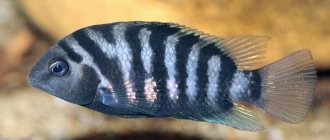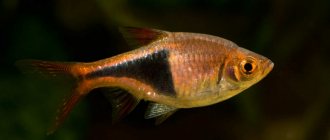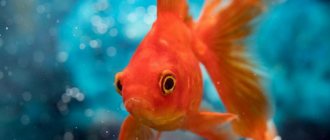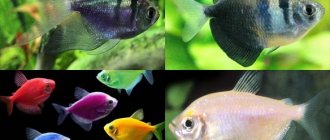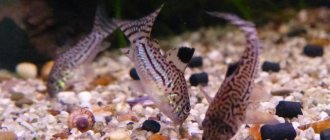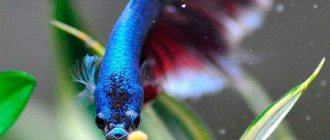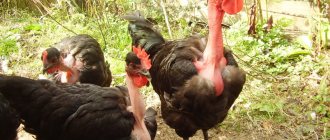Ternetia is a small, popular dark silver fish. It can be found in any pet store and in many home aquariums. Its unpretentiousness in maintenance, ease of breeding, and peaceful character deserve the attention of beginners in the aquarium hobby.
Latin name: Gymnocorymbus ternetzi.
Synonyms: Ternetia black, mourning, tetra black widow. Ternetia received this name, first of all, for its gray-black body color and the characteristic “skirt” formed by the developed anal fin.
Bourgeois names : Black skirt tetra, Black Widow tetra, Black tetra.
Order, family: Characinaceae.
Comfortable water temperature: 22 - 26 C.
“Acidity” Ph : 5.7 - 7.0.
Hardness: up to 6-16°.
Aggressiveness: non-aggressive.
Content difficulty: easy.
In nature they live: Brazil, Bolivia: the Mato Grosso, Rio Paraguay, Rio Negro rivers. They live in reservoirs with dense vegetation, which is why, if a home aquarium allows it, it is better to decorate it with live aquarium plants, and provide an area for free swimming in the center.
A little history: thornets appeared in Europe in 1933, and were brought to Russia in 1946. Described by the Belgian-British zoologist and ichthyologist George Albert Boulenger in 1895.
At the moment, it has several popular breeding forms (Veiled Ternetia, Albino Ternetia), artificially colored (“Caramel”) and genetically modified (GloFish Ternetia).
Ternetia photo
Description: The body of the ternation is flat, the color is silver-striped - there are 3 black stripes across the body. One of the stripes passes through the eye. The fins, except the anal one, are transparent. The anal fin is black, fan-shaped. The length of the thorns is 4 - 5 cm. Females are larger and wider than males, with a fuller abdomen.
The fish are energetic, active, and schooling. They are timid and can turn pale from fright and hide in a secluded place.
Compatibility: Ternetias get along well with all small and non-aggressive fish, such as gouramis, angelfish, large tetras, swordtails, zebrafish, corydoratuses, sacbranch catfishes and others.
Incompatibility: It is not recommended to place them with “veiled” fish, slow and frankly small fish. It is not recommended to keep them with neons, guppies and other bipods. At the same time, thornets are not compatible with large and territorial cichlids: cichlasomas, astronotuses, and other predatory fish. It has been noticed that when terentias are kept in a flock, they can bite each other. See the article on aquarium fish compatibility.
Ternetia photo
How long do they live: By aquarium standards, their life is medium-long; under good conditions they can live up to 6 years. On average they live 3-4 years. You can find out how long other fish live HERE!
Minimum aquarium volume: Ternetia can be kept in an aquarium of at least 10 liters, in such an aquarium you can plant 1 or a maximum of two fish. However, these are schooling fish and therefore it is better to keep them in a group in an aquarium of 50 liters or more. Find out how many fish you can keep in X liters of aquarium HERE (at the bottom of the article there are links to aquariums of all sizes).
Subscribe to our YouTube channel so you don't miss anything
Description
Ternetia is a small aquarium fish. Grows up to 5.5 cm.
Appearance
Ternetia has a tall and laterally flattened body. The anal fin is wide, occupies half of the body, the dorsal fin is narrowed. A small adipose fin is present. The fins are translucent. In the common thorn, three dark vertical stripes run along the silvery body: the first crosses the eye, the second is located at the end of the gill covers, the third - from the beginning of the upper fin to the lower part of the abdomen.
Lifespan
Characins live up to 4 years, like many modest-sized fish.
How to distinguish from Glofish?
In addition to Caramels, Ternetia Glofish is often found in pet stores. This species is genetically modified: jellyfish genes are introduced into the organisms of embryos, due to which the fish acquires a bright fluorescent color. The advantage of this method is that the fish are not exposed to the harmful effects of chemicals, and the genetic code is inherited.
At first glance, Glofish and Caramel are no different from each other, but experienced aquarists can immediately see the differences. The fact is that the body of Glofish itself has a certain shade, which even extends to the eyes and fins. Caramels appear paler - usually only the top and head are best colored, while the belly remains greyish-white.
As an example, here are two photographs that show Caramel and Glofish alternately, after looking at which it will immediately become clear who is who.
Caramel - only the top part and a little bit of the bottom of the tail are colored.
Glofish - the entire body is painted, with 3 stripes across the body. Sometimes these fish are mistaken for Caramels, because... It is believed that Glofish cannot have transverse stripes on its body, but in fact this is not so.
And these are classic Glofish (no transverse stripes) - the whole body is painted, including the head.
Ternetias are not the only genetically modified fish that glow in the dark; Danio Glofish also has this effect.
Kinds
The genus of ternation includes several types and forms:
- Veiled. The veil blackskirt or mourning is an artificially bred form with long fins wavy on the sides. The fins look like a long black skirt, which attracts attention to the inhabitant of the aquarium. Difficult in content.
- Albino. Light color, reddish eyes. There are no transverse stripes on the body. The veil form is rare.
- Caramel. It is dyed by applying dye under the skin. The bright color of such individuals disappears quickly. Caramel thorns live shorter than their natural counterparts and have weak immunity. There are different colors: pink, green, blue, red, purple.
- GloFish is another colorful variation of aquarium fish. GloFish inherits fluorescent color. The average life expectancy is the same as that of black thorns. Colored at the gene level.
- Golden. Light gold fish with a silver tint. There are no stripes on the body.
The price of thorns
Ternetias are widespread and can be found in any pet supply store or purchased online. Buying caramels is more expensive than buying ordinary thorns, ranging from 100-130 rubles.
The price depends on color preferences, order volume, age and condition of the fish. Pink thornia is very popular . Bright caramel delights lovers and delights children with its appearance.
No matter how much you have to pay for live fish, the real price is measured not by banknotes, but by genuine interest in the unusual world of the inhabitants of foreign rivers. It is human nature to conduct experiments and transform the world— the thorns in the photo are proof of this. The purchase of fish obliges the aquarist to treat the small and fragile life of caramels with care and attention.
Feeding
Ternetias are unpretentious to food and are omnivores. Diet components:
- dry food in the form of small flakes;
- bloodworm;
- tubifex;
- gammarus;
- daphnia;
- brine shrimp
Serve frozen and live foods. Do not overuse dry food. Food must be near the surface of the water so that the thorns can eat it. Feed your pets 1-2 times a day in portions eaten within 3-5 minutes. When buying food, check expiration dates. Frozen food cannot be re-frozen.
Approximately how much do they cost?
The price of fish varies greatly. The cheapest are ordinary thornets, which can be bought for even 50 rubles (although usually more expensive). Caramels and glofishes are much more expensive - more than a hundred rubles, and the price of some glofishes (for example, can exceed 400).
As you can see, ternetia, due to its unpretentiousness and ability to live with many types of fish, is perfect for beginners. The variety of colors of glowfish allows you to choose a fish of any desired color. Finally, they are easy to breed in captivity, which will allow you to maintain the population and even create your own hybrids.
The only advice is that it is still better to refrain from buying caramels - these fish are essentially sick and crippled due to such operations, and glowfish will be a good replacement for them.
Compatibility
Ternetias are peaceful and active aquarium fish.
They get along with species of similar size and character and harmless catfish:
- neon;
- platies;
- mollies;
- zebrafish;
- platies;
- tetras;
- peaceful barbs;
- iris;
- corridors;
- rasborami.
Compatibility with those with veil fins, predators and other large fish is low; thornia is not compatible with the following species:
- goldfish;
- cichlids;
- astronotuses;
- guppy;
- cockerels.
How to choose the right one when buying, what to look for?
Ternetias are very active fish that should behave agilely and playfully. It is worth paying special attention to the color of the body: it should have a uniform color without spots or light areas. A lethargic, slow and pale fish is unlikely to live long in your aquarium.
Regardless of the condition of new pets, they need to be kept in a quarantine aquarium for a couple of weeks, and only then released into the general aquarium. Healthy Caramels, with proper care, will delight the owner for a long time with their playful character and attractive appearance.
Reproduction
Characins are easy to breed at home. It is important to provide the necessary care and pay special attention to the fry.
Sex differences
Determine the sex by the shape of the fins. The dorsal fin of the male is pointed and narrowed; closer to the tail, the anal fin narrows. Males are slimmer than females and slightly smaller.
Spawning
Puberty occurs at 8 months of age. Individuals older than 2 years cannot spawn. Ternetias reproduce in a previously prepared spawning tank:
- prepare an aquarium from 15 l;
- Place mosses and bushes of plants at the bottom;
- set the temperature to 28 degrees;
- acidity should be 6-6.5;
- provide good aeration.
4-5 days before spawning, feed the breeders with protein food. Place the future parents in the spawning tank. During the spawning process, the male begins to chase the female around the aquarium.
The female lays up to 1000 eggs. To prevent the parents from eating the eggs, remove the spawners from the spawning area. Keep the temperature high and treat the water with methylene blue. The eggs are incubated for 24 hours, and the emerging larvae swim freely after 72 hours. At this time, start feeding the fry; their diet should consist of:
- Artemia nauplii;
- live dust;
- ground food for adult fish;
- ciliates.
Settlement, optimal ratio of the number of males and females
As already noted, at least 10 liters of water should be allocated for Ternetia alone. They do well when housed in a flock of at least 6-7 individuals. Taking into account the fact that other pets will probably be placed in the aquarium, and the soil, shelters and plants “conceal” the space, its recommended volume starts from 100 liters.
As a rule, a certain hierarchy always develops within a flock. Males compete with each other to determine who will receive the most attention from females in the future. Sometimes some individuals can intimidate weak fish in order to increase their authority in the school.
In this regard, it is recommended to purchase the same number of females and males, or keep more “girls” so that the attention of the “boys” is dispersed among the remaining individuals. In a normal situation, the strongest fish is usually identified, which becomes a kind of leader of the school. Other Ternetii swim behind her and repeat her movements.
By the way, read about the nuances of the difference between a female Ternetia and a male here.
Diseases
Characins have good health. If maintained incorrectly, they encounter standard diseases:
- Neon disease. Accompanied by white areas under the skin that restrict movement. In the advanced stage, the spine becomes bent. Replace the sick individual, provide it with good care, then there is a high probability that the fish will recover.
- Oodiniumosis. Introduced with new fish and plants. A golden coating appears on the body, coordination of movements is impaired, and the fish itch against the decorations and stones. The disease can be prevented by creating a quarantine for new individuals. Keep the fish in a separate aquarium for a month and monitor its condition. Treat plants in a slightly pink solution of potassium permanganate or water conditioners. Oodiniumosis is treated with copper sulfate with an increase in temperature.
- Poisoning. In unsettled tap water, thorns can be poisoned by chlorine. Ammonia poisoning occurs when the aquarium is not cleaned frequently.
- Tuberculosis. It is brought into an aquarium with a sick fish. A sick individual hides, does not eat, and the body becomes deformed. Keep the aquarium clean and inspect the fish periodically.
Maintenance and care in the aquarium
Ternetia is a pack animal. One aquarium can contain 8-10 individuals. It is not recommended to plant fish one at a time, otherwise they will be hostile to the rest of the inhabitants. For a small flock you will need an aquarium with a total capacity of 60 liters or more. Ternetias are prone to jumping out of the water, so it is better to get a lid.
Suitable soil would be sand of any fraction, small pebbles or gravel. Driftwood, clay houses, tall and dense thickets of plants are suitable as decorative elements.
Fish do not like intense lighting. It is recommended to install weak diffused light, which will be partially covered by tall, broad-leaved plants.
Ternetia loves clean water, with a normal content of nitrates and phosphates. To provide good conditions for the fish, you will have to acquire a filter and a compressor for aerating the water. In order to create the effect of “dark water”, as in natural conditions, you can add a special tinting conditioner from the Tetra company to the aquarium.
To maintain a bright and colorful body color for species such as caramel and glofish, there are foods with natural color enhancers.
As for the remaining parameters, you must comply with:
- Temperature within 22-26 degrees Celsius;
- Hardness no more than 20 dGH;
- Acidity from 6 to 7.5 pH.
As mentioned above, in the natural environment, fish feed on insects and various larvae. To provide a complete diet in aquarium conditions, you will have to acquire high-protein food.
There are many quality fortified flakes or small granules available. They stay on the surface longer, making it easy for fish to eat them.
Also, to maintain a bright and colorful body color for species such as caramel and glofish, there are foods with natural color enhancers.
In addition, thorns perfectly eat live and frozen food - daphnia, bloodworms. From time to time you can throw chopped spinach or zucchini to the fish. A complete, balanced diet is the basis for strong immunity and a healthy appearance.
Photo
Habitat
Ternetia lives in South America in the rivers Mato Grosso, Paraguay, Rio Negro and Guapora. The fish prefers slow-moving waters with a lot of plants. In such places, the water is shaded from the sun by tree branches. The water there is soft and acidic, and its color is dark due to the large number of branches in the water. Thorns swim mainly in the upper layer of water and eat insects that have fallen into the water.
Adviсe
- For dark thirds, choose a light background. And bright GloFish look impressive against a dark plain background.
- Place the aquarium away from sunlight to prevent algal blooms.
- Do not turn on the aquarium lights suddenly. First, turn on the light in the room, let the fish get used to the light, after which you can turn on the aquarium lamp.
- The exact water temperature in the aquarium can be determined using an immersion thermometer. A sticker thermometer gives results with errors.
Ternetia is an interesting aquarium fish that changes color depending on its mood. When frightened, the fish's body turns dirty silver.
Previous
FishSmall aquarium fish cardinal
Next
Fishes: Angelfish in the aquarium?
Diseases
With improper care, various diseases can occur. The main and most common ones:
- Alkali disease. Occurs with increased acidity of water and strong lighting.
- Acidic – with low acidity of water.
- Acedemia – with increased ammonia content.
- Hypoxia occurs in all fish if the aquarium is overcrowded. It is necessary to take into account the number of fish and the volume of the aquarium.
- Chlorosis - when pouring poorly settled water.
Treatment of all diseases comes down primarily to the establishment of living conditions. It is also recommended to increase the water temperature to 30°C.
Aquarium thorns are hardy and suitable for any aquarist. They reproduce well and are not fussy in their maintenance. If you follow the basic nuances of care, the fish will live for at least 5-6 years.
